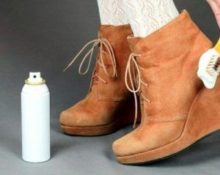 Winter is a wonderful, favorite time of year for many. However, it is the winter months that are the most dangerous. Proven folk methods and professional remedies will help protect yourself from falls.
Winter is a wonderful, favorite time of year for many. However, it is the winter months that are the most dangerous. Proven folk methods and professional remedies will help protect yourself from falls.
TOP 10 ways
Special devices. Ice drifts and ice accesses are the number one protection against slipping. These are spiked pads on rubber straps that are attached to the toe and heel of the shoe. People also call them winter horseshoes. Finding such devices on sale is not difficult.
- Heels, nails, screws. Equipping the sole and heel with metal elements will make the shoes stable and safe. Heels are an option for women's high-heeled boots. Screws and nails are the solution for flat soles. In order not to spoil your favorite couple, the work should be entrusted to a professional, especially since such services are inexpensive.
Important. This method is only suitable if the platform is sufficiently dense and thick.
- Sandpaper. There are two ways to reduce slipping using sandpaper. The first is to periodically rub the sole with it.The second is to glue several strips of paper with Moment glue or simple PVA. In both cases, the results last for a couple of weeks.
- Felt. Old unnecessary felt boots can do a good job. Cut out a few pieces, glue them to the sole, wait for a firm fixation and feel free to go outside without fear of ice. The method requires periodicity, since the felt wears off when walking. The procedure must be repeated approximately once every 10 days.
- Glue. PVA or “Moment” should be applied in a pattern and wait until it dries. You can consolidate the effect by covering a fresh layer with plain sand.
- Sand. Street sand can also be used as an independent protective agent, which will last throughout the winter. Place it on a baking sheet and heat in the oven. After this, place shoes with a rubber base on it: the hot particles will remain on the sole.
Important. Make sure that the platform does not melt, otherwise you risk saying goodbye to your boots.
- Band-Aid. In the most emergency cases, a regular pharmacy patch will help. Cut out several strips and glue them crosswise in several places. Shoes must be dry and clean. It is important to remember that the method is only suitable for dry weather, and the result lasts for a maximum of two days.
- Drawing. Shoes with patterned plastic soles are not as slippery as those with smooth soles. If there is no design, make it yourself using a regular nail or knife. The main thing when creating a relief is not to accidentally pierce the soles.
- Capron. Old nylon tights will also come in handy in the fight against ice. Set them on fire above the sole: the molten drops will fall directly onto it and, solidifying, form a reliable anti-slip tread.
- Water repellent. Spray to protect shoes from moisture will also reduce slipping. However, this is a one-time method: the product will have to be reapplied before each time you go outside.
What to do with sneakers to prevent them from slipping?
 Sneakers that glide not only on ice deserve special attention. The cause of a fall may be a wet or simply smooth floor.
Sneakers that glide not only on ice deserve special attention. The cause of a fall may be a wet or simply smooth floor.
- Silicone pads are a great way to make slippery shoes more stable. It is better if they are glued by a professional.
- To prevent your sneakers from slipping during exercise, wet the platform with Coca-Cola and leave them on for 15-20 minutes. The procedure must be done every time before visiting the gym.
- Some of the above methods are also suitable: molten nylon, a mesh of glue, an adhesive plaster and a water-repellent agent.
Slippery soles are not a reason to give up your favorite shoes. Solving the problem and protecting yourself from possible injury requires some creativity and a little patience.


 0
0





